Chowder is a type of soup that is known for its unique combination of ingredients. To be classified as a chowder, a soup must have two main components – a base of seafood or chicken, and a mix of vegetables including onions, celery, and potatoes. These two ingredients are essential to creating the rich and flavorful texture that chowder is famous for.
Most chowders have a creamy consistency, but there is one notable exception – Manhattan clam chowder, which has a tomato base. The traditional method of making chowder involves sautéing bacon (optional) to render its fat, then sweating the vegetables in the flavorful fat. Potatoes and liquid such as milk, cream, stock, or tomatoes are added, and the chowder is simmered until everything is cooked through.
Thickening agents such as roux made of flour and fat, potatoes, or cornstarch can be used to achieve the desired consistency. Some popular chowder variations include clam chowder, corn chowder, chicken chowder, potato chowder, and seafood chowder made with various types of fish or shellfish.
When serving chowder, it is common to accompany it with oyster crackers, which provide a satisfying crunch. Chowder has a rich history that dates back to the 18th century, and different regions have developed their own unique variations. The most famous type of chowder is New England clam chowder, known for its creamy base. Manhattan clam chowder, on the other hand, stands out with its vibrant tomato-based broth.
Key Takeaways:
- A chowder must have a base of seafood or chicken and a mix of vegetables including onions, celery, and potatoes.
- Most chowders are creamy, but Manhattan clam chowder has a tomato base.
- The traditional method of making chowder involves sautéing bacon, sweating vegetables, adding potatoes and liquid, and simmering until cooked through.
- Thickening agents like roux, potatoes, or cornstarch can be used to achieve the desired consistency.
- Popular types of chowder include clam, corn, chicken, potato, and seafood chowder.
Understanding the Definition of Chowder
To be considered a chowder, a soup must meet specific ingredient requirements. It is essential to understand the definition of chowder, as it sets this type of soup apart from others. Traditionally, chowder consists of two main components: a base made with either seafood or chicken, and a mix of vegetables that typically includes onions, celery, and potatoes.
“Chowder is a comforting and hearty soup that is enjoyed by many. It is characterized by its rich and creamy texture, although one variation, known as Manhattan clam chowder, features a tomato base instead. The combination of seafood or chicken with a medley of vegetables gives chowder its distinctive flavor and appeal.”
In the process of making chowder, bacon is often sautéed first, adding a smoky flavor to the soup. The rendered fat from the bacon is then used to sweat the vegetables and infuse them with additional flavor. Potatoes and liquid, such as milk, cream, stock, or even tomatoes, are incorporated into the soup and simmered until everything is cooked through. Different thickening agents, such as a roux made of flour and fat, potatoes, or cornstarch, are used to achieve the desired consistency.
Chowder comes in various types, with clam chowder being one of the most popular choices. Other well-known variations include corn chowder, chicken chowder, potato chowder, and seafood chowder made with different types of fish or shellfish. Oyster crackers are a common accompaniment, adding a pleasant crunch to each spoonful of soup.
The Main Components of Chowder
A chowder typically consists of two key components that give it its distinct flavor and texture: a base of either seafood or chicken, and a medley of vegetables. These ingredients come together to create a hearty and satisfying soup that has been enjoyed for centuries.
When it comes to the base of a chowder, seafood and chicken are the two main options. Seafood chowders often feature fish, clams, shrimp, or lobster, while chicken chowders use chicken breast or thigh meat. The choice of base can greatly influence the overall taste and character of the chowder.
In addition to the base, a mix of vegetables is essential to a classic chowder. Onions, celery, and potatoes are commonly used, providing a savory base and adding texture to the soup. These vegetables are typically sautéed in bacon fat or butter, imparting a rich flavor to the chowder.
| Main Components | Base | Vegetables |
|---|---|---|
| Type | Seafood or Chicken | Onions, Celery, Potatoes |
| Examples | Clam Chowder, Seafood Chowder, Chicken Chowder |
These two components are the foundation of a classic chowder, but variations exist depending on regional preferences and personal tastes. Some chowders incorporate additional ingredients like corn, bacon, or herbs to enhance the flavor profile. The thickness of the chowder can also be adjusted by using a roux, potatoes, or cornstarch as a thickening agent.
Other Chowder Variations
While seafood and chicken chowders are the most well-known, there are other types of chowders that showcase different flavors and ingredients. For example, Manhattan clam chowder, which originated in New York, has a tomato base instead of the traditional creamy base. This variation is known for its vibrant color and tangy taste.
“A chowder typically consists of two key components that give it its distinct flavor and texture.”
Another regional variation is Rhode Island clam chowder, which has a clear broth instead of a creamy base. It allows the flavors of the clams and vegetables to shine through without the addition of dairy. Minorcan clam chowder, hailing from Florida, takes a spicy twist by incorporating datil peppers, a local specialty that adds a kick of heat to the soup.
Whether you prefer a classic seafood chowder, a hearty chicken chowder, or one of the many regional variations, chowder is a versatile and comforting dish that continues to be cherished by soup lovers around the world.
 – A chowder typically consists of two key components: a base of either seafood or chicken, and a medley of vegetables.
– Seafood chowders often feature fish, clams, shrimp, or lobster, while chicken chowders use chicken breast or thigh meat.
– Common vegetables used in chowder include onions, celery, and potatoes, which are sautéed to enhance their flavor.
– Other ingredients like corn, bacon, or herbs can be added to chowder for extra flavor.
– Chowders can be thickened with a roux, potatoes, or cornstarch.
– Manhattan clam chowder has a tomato base, while Rhode Island clam chowder is clear and broth-based.
– Minorcan clam chowder is made with spicy datil peppers.
– Chowder is a versatile and comforting dish loved by soup enthusiasts worldwide.
– A chowder typically consists of two key components: a base of either seafood or chicken, and a medley of vegetables.
– Seafood chowders often feature fish, clams, shrimp, or lobster, while chicken chowders use chicken breast or thigh meat.
– Common vegetables used in chowder include onions, celery, and potatoes, which are sautéed to enhance their flavor.
– Other ingredients like corn, bacon, or herbs can be added to chowder for extra flavor.
– Chowders can be thickened with a roux, potatoes, or cornstarch.
– Manhattan clam chowder has a tomato base, while Rhode Island clam chowder is clear and broth-based.
– Minorcan clam chowder is made with spicy datil peppers.
– Chowder is a versatile and comforting dish loved by soup enthusiasts worldwide.
The base of a chowder is crucial and can be made using either seafood or chicken. These two main ingredients set the foundation for the flavors and textures that define this beloved soup. While seafood chowders are more popular and often associated with chowder, chicken chowders offer a delightful alternative for those who prefer poultry over fish or shellfish.
Seafood Chowder Ingredients
Seafood chowder typically includes a variety of seafood such as clams, shrimp, crab, or fish. The choice of seafood largely depends on personal preference and availability. Along with the seafood, ingredients like onions, celery, carrots, and potatoes add depth and flavor to the soup. Cream or milk is commonly used to create a rich and creamy base, while herbs and spices like thyme, bay leaves, and black pepper enhance the overall taste. The result is a hearty and satisfying chowder filled with the flavors of the sea.
Chicken Chowder Ingredients
For those who prefer poultry, chicken chowder is an excellent choice. It typically features diced or shredded chicken, along with the same vegetables like onions, celery, and potatoes. The base can be made with chicken broth, cream, or a combination of both. This variation provides a comforting and savory option, perfect for those who enjoy the flavors of chicken in a rich and creamy soup.
Whether you opt for seafood or chicken as the base, chowder is a versatile dish that can be customized to suit your taste. Experiment with different ingredients and variations to create a chowder that satisfies your cravings and warms your soul.
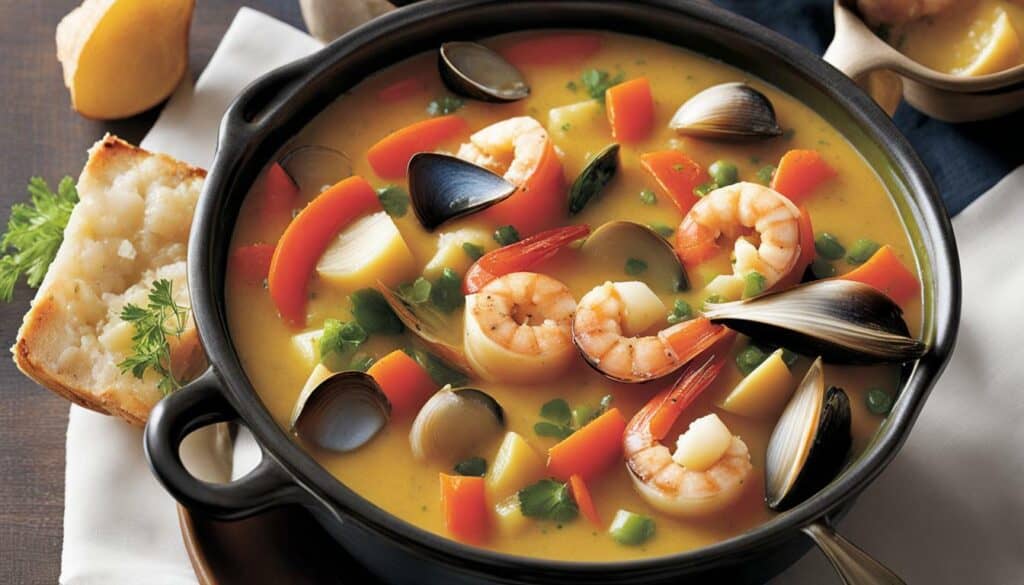
| Seafood Chowder Ingredients | Chicken Chowder Ingredients |
|---|---|
| Clams | Chicken |
| Shrimp | Onions |
| Crab | Celery |
| Fish | Potatoes |
| Onions | Chicken Broth |
| Celery | Cream |
| Carrots | |
| Potatoes | |
| Herbs and Spices | |
| Cream or Milk |
The Mix of Vegetables
In addition to the base, chowder requires a medley of vegetables to create its hearty and flavorful character. Traditional chowder recipes typically include onions, celery, and potatoes as the primary vegetable ingredients. These vegetables not only add texture and depth to the soup but also complement the rich flavors of the seafood or chicken base.
“I believe the key to a delicious chowder lies in the balance of vegetables,” says Chef James Peterson, a renowned expert in culinary arts. “The combination of onions, with their savory sweetness, celery for its subtle crunch, and potatoes for their creamy texture, creates a harmonious blend of flavors that enhances the overall taste of the chowder.”
To highlight the importance of these vegetable ingredients, here is a table summarizing their role in different types of chowder:
| Chowder Type | Vegetable Ingredients |
|---|---|
| Clam Chowder | Onions, celery, potatoes |
| Corn Chowder | Onions, celery, potatoes, corn |
| Chicken Chowder | Onions, celery, potatoes, carrots |
| Potato Chowder | Onions, celery, potatoes |
| Seafood Chowder | Onions, celery, potatoes, carrots |
As shown in the table, these vegetable ingredients are versatile and can be adapted to various chowder recipes. The combination creates a robust and comforting soup that is perfect for chilly nights or as a filling meal on its own.

The success of a chowder recipe lies in the skillful balance of ingredients. While the seafood or chicken base provides the foundation, the mix of vegetables such as onions, celery, and potatoes adds depth and flavor to the chowder. Whether you prefer classic clam chowder or adventurous variations like corn or seafood chowder, these vegetable ingredients play a crucial role in creating a delicious and satisfying bowl of chowder.
Classic Chowder Preparation Method
The process of making a classic chowder involves several essential steps to achieve its desired consistency and taste. Whether you opt for a seafood or chicken base, the combination of flavors and textures will create a hearty and satisfying soup. Here is a step-by-step guide on how to make a delicious and authentic chowder:
- Saute the Bacon (optional): In a large pot, cook bacon until crispy and golden brown. This will add a smoky flavor to the chowder. If you prefer a vegetarian version, simply skip this step.
- Sweat the Vegetables: Add onions, celery, and any other desired vegetables to the pot with the rendered bacon fat. Sweat them until they become soft and translucent, releasing their natural flavors.
- Add Potatoes and Liquid: Peel and dice potatoes into bite-sized pieces, then add them to the pot along with your choice of liquid. Traditionally, milk, cream, or chicken/seafood stock is used. You can also use tomatoes for a unique twist, as in Manhattan clam chowder.
- Simmer: Allow the chowder to simmer gently over low heat until the potatoes and vegetables are cooked through and tender. This will infuse the flavors together and create a rich, creamy texture.
- Thicken (optional): Depending on your preference, you can thicken the chowder using a roux made from flour and fat, or by adding mashed potatoes or cornstarch. This step gives the chowder its signature thickness.
- Season and Serve: Taste the chowder and adjust the seasoning with salt, pepper, and any other desired herbs or spices. Serve the chowder hot, garnished with fresh herbs and accompanied by oyster crackers for that extra crunch.
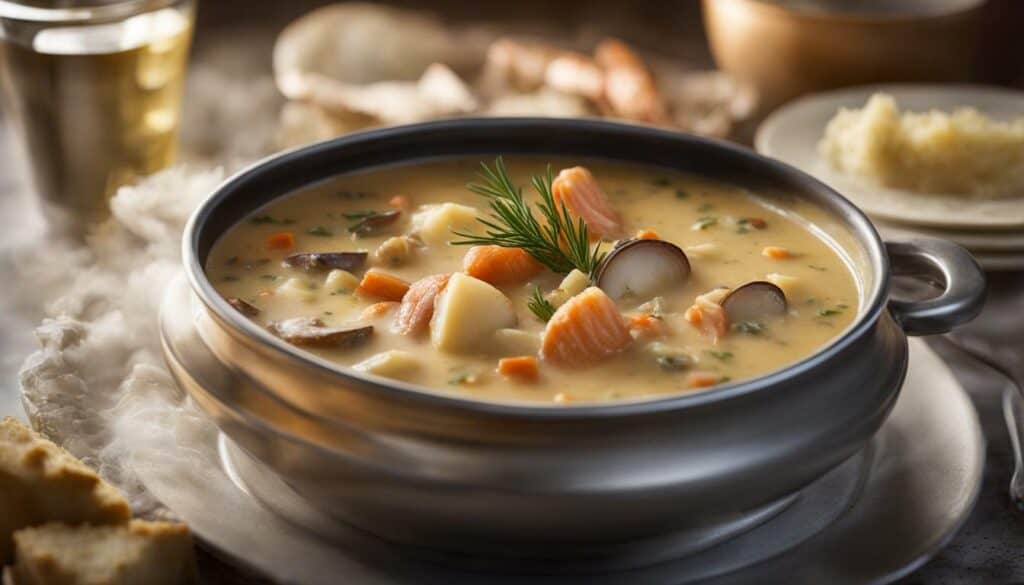
With this classic chowder preparation method, you can enjoy a comforting bowl of soup that is packed with flavor and warmth. Remember to experiment with different ingredients and variations to create your own unique twist on this beloved dish. Happy cooking!
Popular Types of Chowder
Chowder comes in various types, each with its own unique combination of ingredients and flavors. From the rich and creamy New England clam chowder to the zesty tomato-based Manhattan clam chowder, there is a chowder to suit every palate.
New England Clam Chowder
“A classic comfort food, New England clam chowder is known for its rich and creamy texture. Made with clams, potatoes, onions, celery, and bacon, this chowder is a beloved staple in the Northeastern United States. It is typically thickened with a roux made from flour and fat, resulting in a hearty and satisfying dish.”
Manhattan Clam Chowder
“In contrast to its creamy counterpart, Manhattan clam chowder has a vibrant tomato base. This chowder includes ingredients such as clams, tomatoes, onions, celery, green peppers, and seasonings like oregano and bay leaves. The combination of flavors creates a tangy and slightly spicy chowder that is widely enjoyed in the New York City area.”
Other Types of Chowder
Aside from the popular New England and Manhattan varieties, there are other lesser-known types of chowder that showcase regional flavors and ingredients:
- Rhode Island Clam Chowder: This clear and broth-based chowder features clams, potatoes, onions, and bacon. It is seasoned with herbs and spices, offering a lighter alternative to the creamy chowders.
- Minorcan Clam Chowder: Hailing from the coastal region of Florida, this chowder is made with clams, vegetables, and the distinctive datil peppers. It has a spicy kick that sets it apart from other chowder varieties.
As you can see, the world of chowder is vast and diverse, offering a range of flavors and ingredients to satisfy every taste. Whether you prefer the creamy richness of New England clam chowder or the zesty tang of Manhattan clam chowder, there is a chowder out there waiting to tantalize your taste buds. So, why not explore the different types of chowder and discover your new favorite?
Accompaniments to Chowder
Experience the full enjoyment of chowder by pairing it with the perfect accompaniments. Chowder is a versatile soup that can be enhanced by a variety of side dishes and condiments. Whether you prefer a classic New England clam chowder or a hearty seafood chowder, these accompaniments will take your chowder experience to the next level.
1. Oyster Crackers
One of the most popular accompaniments to chowder is a bowl of crispy oyster crackers. These small, bite-sized crackers add a satisfying crunch to each spoonful of soup. Their mild flavor complements the rich and creamy base of chowder, making them the perfect vessel for scooping up every last bit of the soup.
2. Freshly Baked Bread
Another classic pairing for chowder is a slice of freshly baked bread. Whether you choose a crusty baguette, a soft dinner roll, or a slice of sourdough, the bread provides a hearty and comforting element to balance the flavors of the soup. Use it to soak up the creamy broth or simply enjoy it on its own alongside each spoonful of chowder.
3. Simple Green Salad
To add some freshness and a contrasting texture to your chowder meal, consider serving a simple green salad on the side. The crisp lettuce, juicy tomatoes, and tangy vinaigrette will provide a refreshing break from the rich and creamy flavors of the soup. It’s a great way to incorporate some vegetables into your meal and create a well-rounded dining experience.
| Accompaniment | Description |
|---|---|
| Oyster Crackers | Small, bite-sized crackers that add crunch and mild flavor to chowder. |
| Freshly Baked Bread | Crusty baguette, soft dinner roll, or a slice of sourdough to complement the flavors of the soup. |
| Simple Green Salad | Crisp lettuce, juicy tomatoes, and tangy vinaigrette to provide freshness and contrast. |
Remember, the best accompaniments to chowder are the ones that suit your personal taste preferences. Whether you prefer the traditional oyster crackers or want to experiment with different bread varieties and salad combinations, the goal is to enhance and balance the flavors of the chowder. So, grab a bowl of your favorite chowder, pair it with the perfect accompaniments, and savor every delicious spoonful.
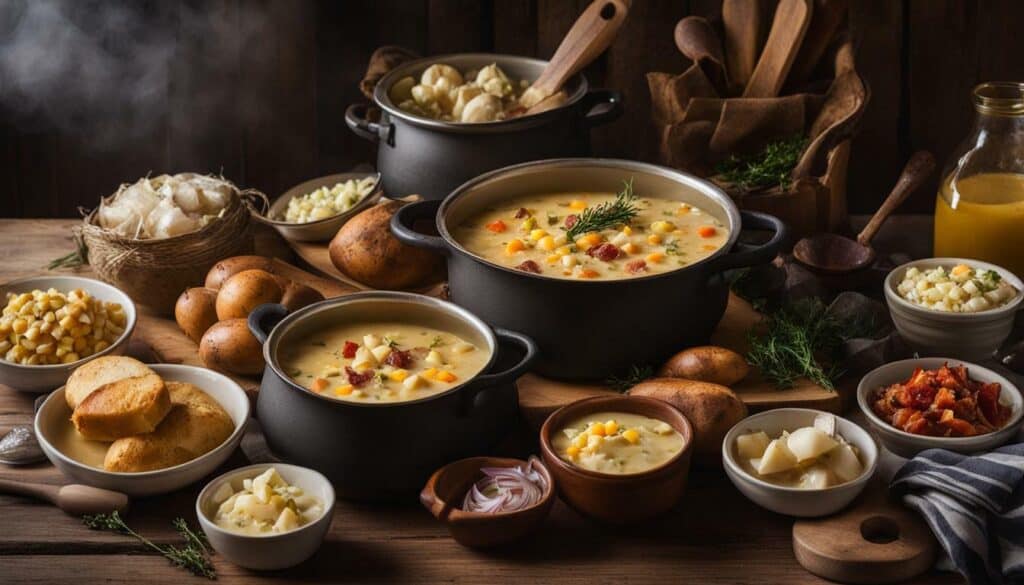
The History and Regional Variations of Chowder
Chowder has a rich history dating back to the 18th century, with different regions putting their own unique spin on this beloved soup. As settlers arrived in America, they brought with them their culinary traditions and adapted them to the local ingredients available. Thus, chowder was born, evolving into a comforting and hearty soup that has become a staple in many households.
One of the most famous variations of chowder is New England clam chowder. This creamy soup features tender clams, potatoes, onions, and celery, simmered in a rich broth made with milk or cream. The addition of smoky bacon adds another layer of flavor, making it a beloved dish in the northeastern United States.
On the other hand, Manhattan clam chowder takes a departure from the traditional creamy base. This variation is known for its vibrant red color, thanks to the inclusion of tomatoes. It combines clams with a medley of vegetables like carrots, celery, and potatoes, creating a lighter and tangier flavor profile.
| Region | Variation |
|---|---|
| New England | Creamy clam chowder |
| Manhattan | Tomato-based clam chowder |
| Rhode Island | Clear, broth-based clam chowder |
| Minorca (Florida) | Spicy clam chowder with datil peppers |
Other regional variations of chowder include Rhode Island clam chowder and Minorcan clam chowder. Rhode Island clam chowder differs from its New England counterpart, as it is clear and broth-based, allowing the fresh flavors of the clams to shine through. Meanwhile, Minorcan clam chowder, originating from the Florida region of Minorca, is known for its spicy kick, thanks to the use of datil peppers.

Whether you prefer the creamy richness of New England clam chowder or the tangy flavors of Manhattan clam chowder, one thing is certain – chowder has a storied history and continues to evolve in various regions. Each variation offers a unique taste and experience, showcasing the diverse culinary heritage of the United States.
Regional Variations of Chowder
- New England: Creamy clam chowder
- Manhattan: Tomato-based clam chowder
- Rhode Island: Clear, broth-based clam chowder
- Minorca (Florida): Spicy clam chowder with datil peppers
“Chowders have become an integral part of American cuisine, representing the diverse flavors and cooking techniques found in different regions. From the creamy richness of New England clam chowder to the zesty tang of Manhattan clam chowder, each variation offers a unique taste of tradition and history.”
Other Types of Chowder
In addition to the more well-known varieties, there are other types of chowder that offer their own distinct flavors and ingredients. Two such types are Rhode Island clam chowder and Minorcan clam chowder.
Rhode Island clam chowder is a clear broth-based chowder that showcases the natural flavors of the clams. It is typically made with chowder clams, also known as quahogs, which are native to the region. The broth is seasoned with ingredients like salt pork, onions, and potatoes, giving it a savory and comforting taste. The simplicity of this chowder allows the sweetness of the clams to shine through.
On the other hand, Minorcan clam chowder hails from the coastal region of St. Augustine, Florida, and offers a unique twist on the traditional dish. This chowder is known for its spicy kick, thanks to the addition of datil peppers, which are native to the area. The peppers add a fiery heat that complements the briny flavor of the clams. Other ingredients in Minorcan clam chowder include tomatoes, onions, celery, and potatoes, creating a robust and flavorful soup.
Both Rhode Island clam chowder and Minorcan clam chowder showcase the versatility of chowder, with each region putting its own spin on the classic dish. Whether you prefer a clear, brothy chowder or a spicy, tomato-based one, these lesser-known types of chowder are sure to delight your taste buds.

Table 1: Comparison of Rhode Island Clam Chowder and Minorcan Clam Chowder
| Chowder Type | Main Ingredients | Flavor Profile |
|---|---|---|
| Rhode Island Clam Chowder | Chowder clams, salt pork, onions, potatoes | Clear and briny |
| Minorcan Clam Chowder | Clams, datil peppers, tomatoes, onions, celery, potatoes | Spicy and robust |
Conclusion
In conclusion, the presence of seafood or chicken as the base and a mix of vegetables defines a soup as a chowder, making it a comforting and hearty dish loved by many. These two essential ingredients are the key components of a classic chowder, providing a rich and flavorful base to which various vegetables can be added.
Most chowders feature a creamy texture, achieved by simmering the base ingredients with vegetables like onions, celery, and potatoes. However, Manhattan clam chowder breaks the traditional mold by incorporating a tomato base instead. Regardless of the variation, the process of making chowder involves sautéing bacon (optional), sweating the vegetables in the rendered fat, and then adding potatoes and liquid such as milk, cream, stock, or tomatoes.
The thickening of chowder can be achieved through different methods, including the use of a roux made of flour and fat, potatoes, or cornstarch. Popular types of chowder include clam chowder, corn chowder, chicken chowder, potato chowder, and seafood chowder, each offering unique flavors and ingredients. To complement the savory flavors of chowder, oyster crackers are often served as a traditional accompaniment.
The history of chowder traces back to the 18th century, and it has since evolved with regional variations across the United States. New England clam chowder, with its creamy base and use of clams, is undoubtedly the most famous variety. In contrast, Manhattan clam chowder stands out with its vibrant tomato base. Other types of chowder, such as Rhode Island clam chowder and Minorcan clam chowder, showcase regional differences in their preparation methods and ingredient choices, with one being clear and broth-based, and the other being spicy and featuring datil peppers.
FAQ
Q: What are the key ingredients for a soup to be called a chowder?
A: To be called a chowder, a soup must have two main ingredients – seafood or chicken as the base, and a mix of vegetables like onions, celery, and potatoes.
Q: What is the definition of a chowder?
A: A chowder is a type of soup that is defined by its two essential ingredients – a seafood or chicken base and a mix of vegetables.
Q: What are the main components of a chowder?
A: The main components of a chowder include the base (seafood or chicken), a mix of vegetables, and potentially other variations depending on the type of chowder.
Q: What are the base options for making chowder?
A: The base for chowder can be either seafood or chicken. This choice determines the main flavor profile of the soup.
Q: What vegetables are typically used in chowder?
A: Common vegetables used in chowder include onions, celery, and potatoes. These vegetables help to add flavor and texture to the soup.
Q: How is chowder traditionally prepared?
A: Chowder is traditionally prepared by sautéing bacon (optional), sweating vegetables in the rendered fat, adding potatoes and liquid like milk, cream, stock, or tomatoes, and simmering until everything is cooked through.
Q: What are some popular types of chowder?
A: Some popular types of chowder include clam chowder, corn chowder, chicken chowder, potato chowder, and seafood chowder with various types of fish or shellfish.
Q: What are common accompaniments to chowder?
A: Oyster crackers are often served with chowder as a popular accompaniment. These small, crispy crackers add texture to the soup.
Q: What are the regional variations of chowder?
A: Different regions have their own variations of chowder. The most famous type is New England clam chowder, known for its creamy base. Manhattan clam chowder has a tomato base, whereas Rhode Island clam chowder is clear and broth-based. Minorcan clam chowder is spicy and made with datil peppers.
Q: What other types of chowder are there?
A: In addition to the more well-known types, there are other types of chowder such as Rhode Island clam chowder, which is clear and broth-based, and Minorcan clam chowder, which is spicy and made with datil peppers.
What Ingredients Are Used in the Strawberry Macaron Filling Jam?
The strawberry macaron filling jam recipe includes simple yet flavorful ingredients to create a delightful filling. Fresh strawberries, sugar, lemon juice, and pectin are used to make this sweet and tangy jam. When spread between delicate macaron shells, it adds a burst of fruity goodness that perfectly complements the cookie’s crisp exterior.

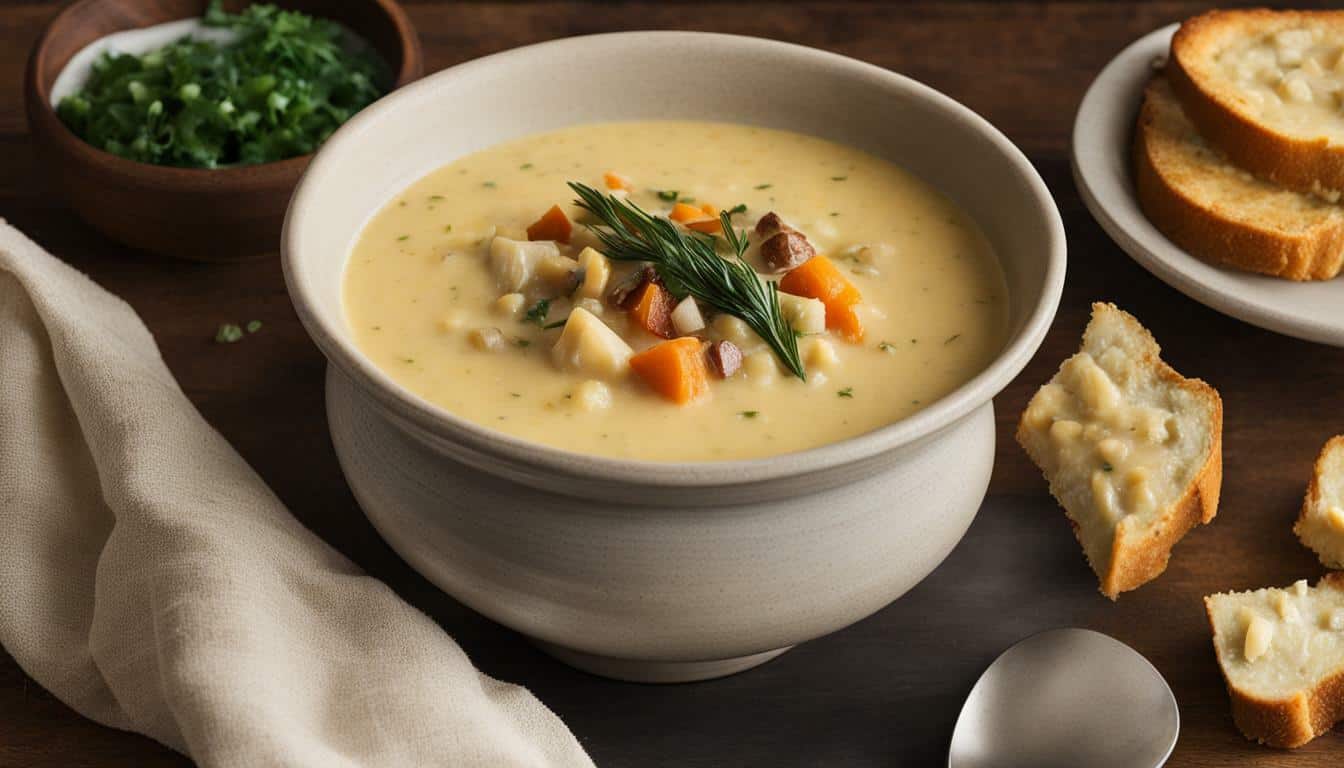

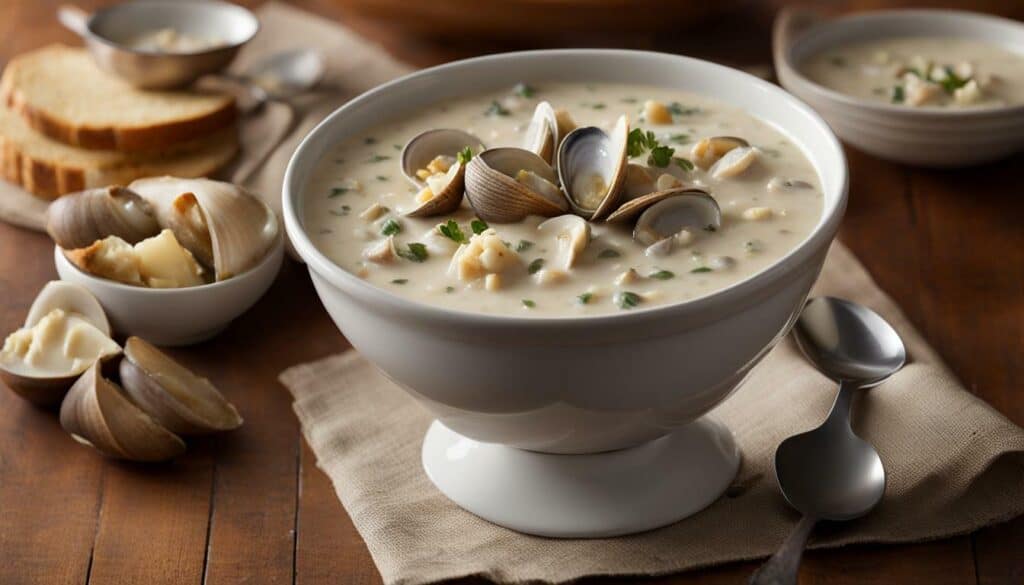
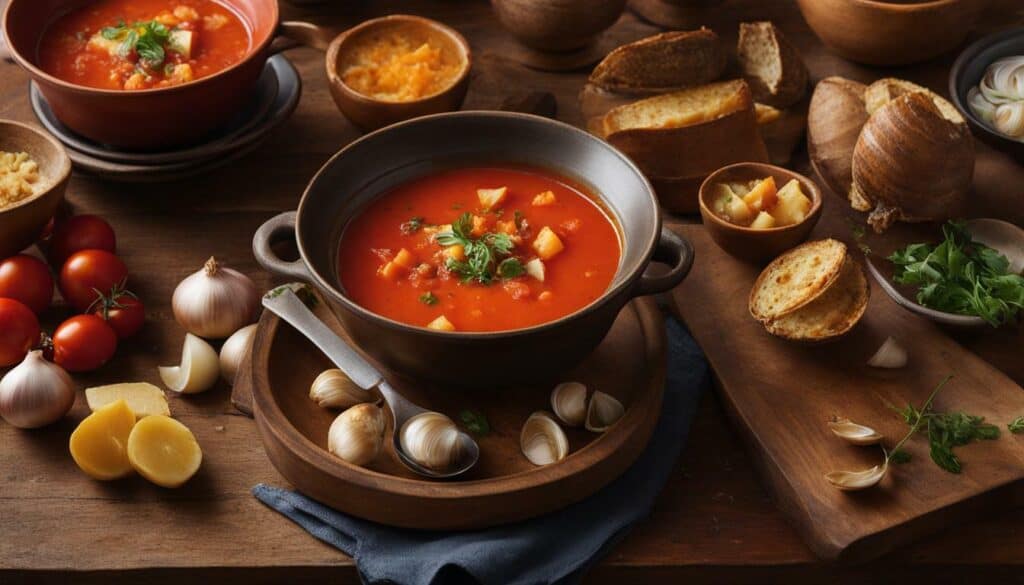



Leave a Reply